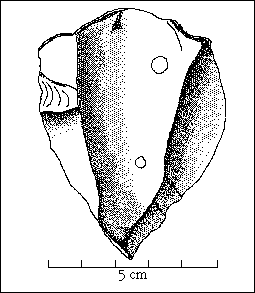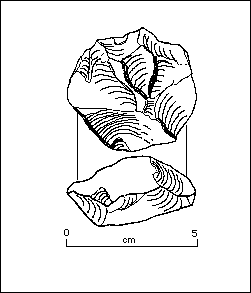 Levallois Dart Point
Levallois Dart PointIn this section you will be introduced to two stone technologies found associated with Middle Paleolithic deposits. The most important point for you to remember about the Middle Paleolithic stone technologies is that the emphasis shifted from core tools, like the Acheulean Handaxe, to flake tools like the Levallois point. Certainly, even at Olduvai, hominids had been taking advantage of sharp-edged flakes and even modifying them for specific tasks. The important difference in the Middle Paleolithic is that cores were being carefully shaped to produce flakes of a predetermined size and shape. The flakes were then further modified into both simple and complex tools.
The stone tool technologies covered in this section include:
The Levallois technique of core preparation and flake removal is the earliest of the core preparation technologies. The technology works in four distinct stages. First the edges of a cobble are trimmed into a rough shape. Second, the upper surface of the core is trimmed to remove cortex and to produce a ridge running the length of the core, Third, a platform preparation flake is removed from one end of the core to produce an even, flat striking platform for the blow that will detach the flake. Finally, the end of the core is struck at the prepared platform site, driving a longitudinal flake off of the core following the longitudinal ridge.
There are two distinct advantages to this technique. The first is that the flakes removed in this manner are already in a preliminary shape, and only require minor modification before being put to use. Second, more usable cutting edge per pound of raw material can be made this way than can be made by producing core tools.
 Levallois Dart Point
Levallois Dart Point
Note how the final shape of this tool closely corresponds to the initial shape of the core from which it was struck. Also, notice how little edge trimming was necessary in order to get a very keen cutting edge on this tool. With care, a number of flakes could be removed from one core, producing much more usable cutting edge with less waste than if the core were thinned into a tool itself.
The Disk Core Technique is not significantly different from the Levallois Technique. The technology still depends on careful core shaping and preparation in order to remove ready-to-use flakes for tools. The principal difference in the Disk Core Technique is that even more refinement and skill went into the core preparation so that more flakes could be removed from one core. Thus, the Disk Core technique is really a refinement of trends started by the Levallois technique. The exhausted cores left behind by this process often look like small disks with multiple flake scars, hence the name.
 An
Exhausted Disk Core
An
Exhausted Disk Core
The most important thing to note about the Disk Core Technique is its efficiency. Using this technique a skilled flinknapper could produce many more usable tools from a single piece of raw material than was possible using any of the other techniques previously discussed.
The process you have just seen would then be repeated, first working the other side of the core, then trimming off the rough top and bottom flake scars, perhaps removing tool flakes from the opposite end of the core. Three to five tools could probably be manufactured from a core this size by a skilled craftsman. Eventually, of course, the core would become too small and thin to produce more tools and would be discarded. This final exhausted discoidal form is all the evidence that we have of this remarkable improvement in the efficiency of lithic technology attained by Neanderthals and archaic Homo sapiens.
You have just been introduced to the two major tool manufacturing techniques in use during the Middle Paleolithic period. If you are working on Assignment 5-2, then you should return to the Exercise menu, by clicking on the "Main" button below, to continue at this point.
|
|
|
|